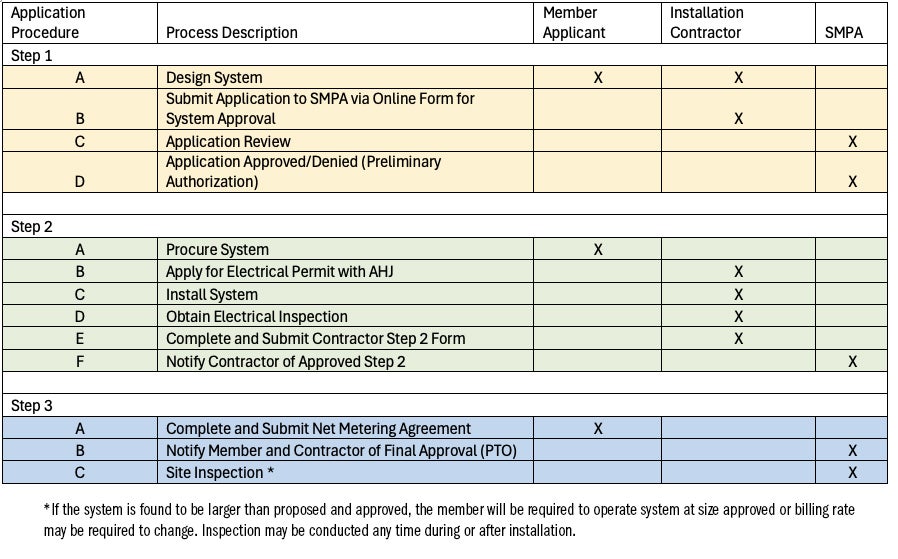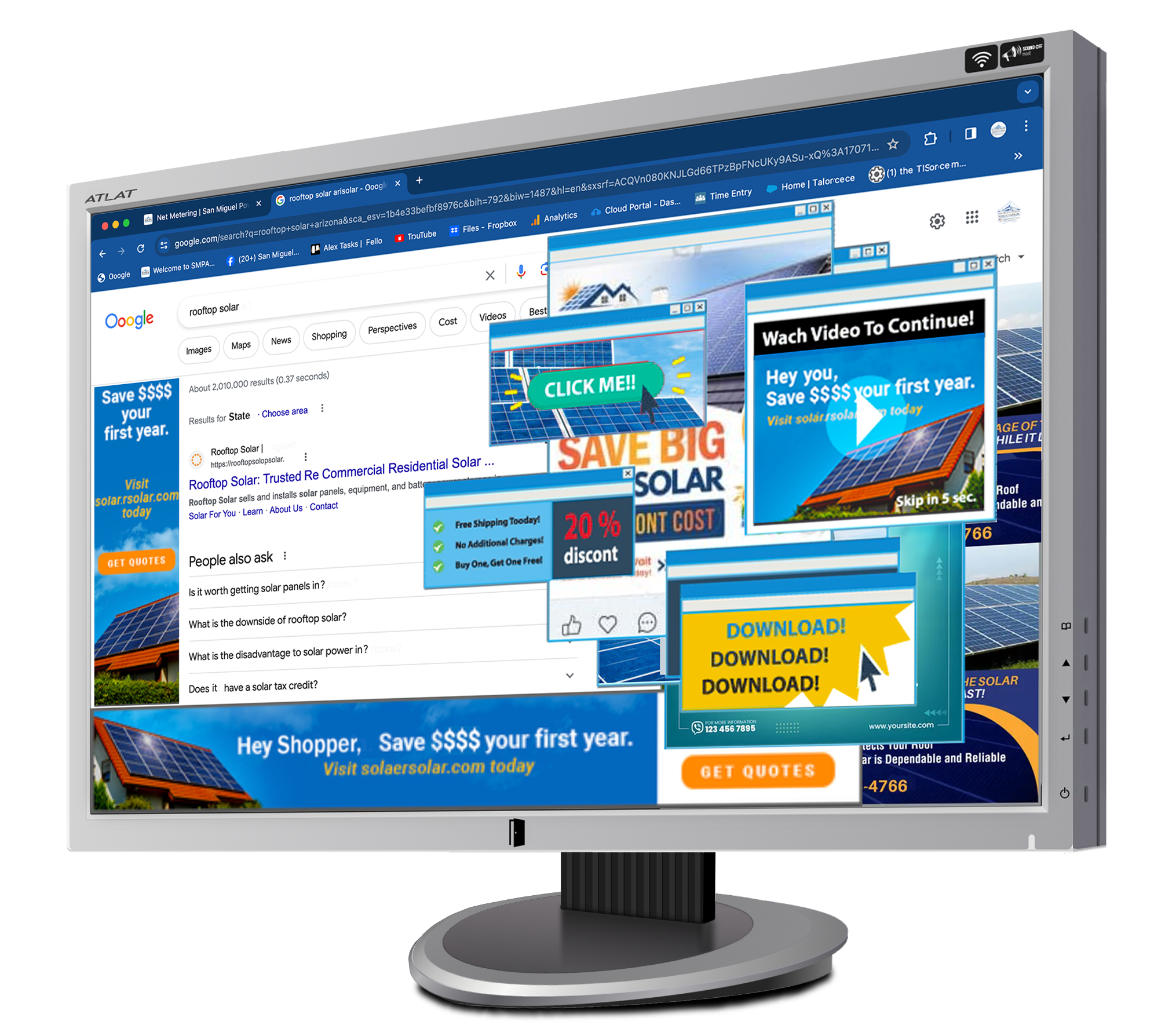What is Net Metering?
Net Metering is a system in which solar panels or other renewable energy generators are installed at a home or business and then connected to a public-utility power grid through a meter that reads electricity flow in two directions. Power from the generator can power electric loads in real time when the renewable resource is available and send excess power to the grid following SMPAs net metering policy and procedure.
SMPA supports members who wish to install these systems on their buildings, and can offer insight and practical advice throughout the process. Keep reading to learn more.
Net Metering Policy
You can view SMPA’s Net Metering Policy here. Please familiarize yourself with our Net Metering Policy before you apply for Net Metering.
Net Metering Application Process

Net Metering Application Procedure
The application is initiated by the contractor (in some cases may be the homeowner for self-installations). A copy of PV Watts Calculator https://pvwatts.nrel.gov/ (recommended) or similar energy estimator is required with Step 1. Once Step 1 has been approved by SMPA, the contractor will receive an email giving permission to move forward with installing the system. Please note, receiving approval for Step 1 may take a few weeks as all proposed systems are now modeled through our engineering department to ensure the affected circuit can handle the system. To help with the timeliest approval, please ensure the account number, member’s name, and service address are correct; the account information can be verified on the member’s most recent bill. Failure to verify this information will result in Step 1 being denied.
The email sent to the contractor giving approval for Step 1 will also contain a link for Step 2. Step 2 will be submitted by the contractor after the system has been installed and passed electrical inspection by the state or AHJ. A copy of the passed electrical inspection and as-built one-line will be required when the contractor completes Step 2. There will be a verification email delivered to the contractor after Step 2 is submitted. This email will need to be reviewed and verified before SMPA can receive the Step 2 submission. Seeing as there may be a significant lag in time between submitting Step 1, installing the system and receiving electrical inspection for Step 2, it will be very important for the contractor to keep this email handy.
When Step 2 is approved by SMPA, the member will receive an email requesting their signature on the Net Metering Agreement. The member and contractor will receive an email granting permission to operate after Step 3 is signed by the member and given final approval by SMPA. To gain final approval for Step 3, the agreement must be completed and signed by the member listed on the account. If Step 3 is not signed by the member listed on the account, Step 3 will be denied.
Additional Net Metering Information
Each month, the kWh total that your system puts onto the grid will be credited against the kWh total that you used from the grid. If your system put more kWh onto the grid than you used from the grid, the excess will be reserved in your “bank” and applied as credit in future months as needed. How credits accrue in your bank will look different depending on your billing rate.
See below for rate options:
Default rate: Time-Of-Use Energy
- Access Fee: $ 28.00/month
- On-Peak kWh: $0.22/kWh
- Off-Peak kWh: $0.11/kWh
As a net metered account you would have 2 kWh banks for monthly excess kWh, one "On-Peak" bank and an "Off-Peak" bank. Energy pushed back to the grid would be accrued in the different banks, based on what time of day it occurred. KWh credits will not transfer between banks. On-Peak is 4-9PM.
Optional rate: Time-of-Day Peak Power
- Access fee: $30.00
- Energy: $0.1196 /kWh
- Peak Power Charge: $3.50 per kW (monthly max during peak hours of 4-9PM)
*kW currently appears on your bill
This option would have one bank for all monthly excess kWh.
You may elect for the optional Time-of-Day Peak Power rate here.

-Your SMPA meter will not be replaced with a special “net” meter. In most cases, the meter you have now is the same meter that will be used for net metering.
Call Before You Sign! Be Wary of Solar Scams.
 With the increased focus on renewable energy nationwide, attention on solar has grown. Be wary of too-good-to-be-true offers from solar salespeople and consider the following before signing any contracts:
With the increased focus on renewable energy nationwide, attention on solar has grown. Be wary of too-good-to-be-true offers from solar salespeople and consider the following before signing any contracts:
- High-pressure sales tactics: Solar scammers often use high-pressure sales tactics to pressure you into signing a contract. They may try to make you feel like you're missing out on a great deal or that you'll regret not signing now. If you feel pressured, it's best to walk away.
- Unrealistic promises: Solar scammers often make unrealistic promises about how much money you can save with solar panels. They may say that you'll be able to eliminate your electric bill entirely or that you'll make a lot of money by selling your excess solar power back to the grid. It's important to do your research and understand the true costs and benefits of solar before you sign any contracts.
- Hidden fees: Solar scammers often hide hidden fees in their contracts. These fees can add up quickly and make your solar installation much more expensive than you expected. Be sure to read the contract carefully and ask about any fees that you don't understand.
- Unlicensed or unqualified contractors: Solar scammers are often unlicensed or unqualified contractors. This means that they may not be properly insured or that they may not have the experience or expertise to install solar panels properly. Make sure to check the contractor's credentials before you hire them.
If you're considering solar, it's important to do your research and be aware of the potential for scams. Here are some tips to help you avoid solar scams:
- Contact SMPA. We have worked with hundreds of SMPA members who have successfully adopted solar, and we can help walk you through the policy requirements for net metering.
- Get multiple quotes from different LOCAL solar companies.
- Read the contract carefully and ask about any fees that you don't understand.
- Make sure the contractor is licensed and qualified.
- Check the company's reputation online.
- Don't feel pressured into signing a contract right away.
If you think you've been the victim of a solar scam, there are resources that can help. The Colorado Solar and Storage Association (COSSA) is a trade association that represents the solar industry in Colorado. Visit their website for more information.

